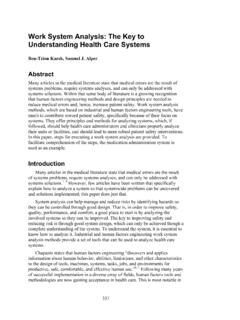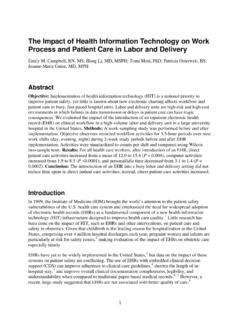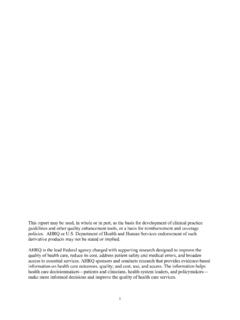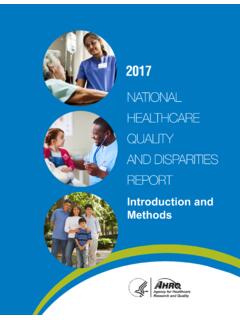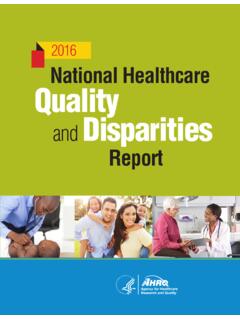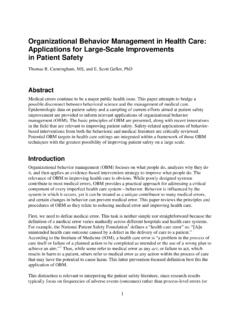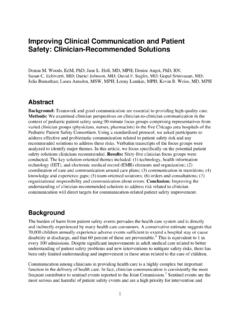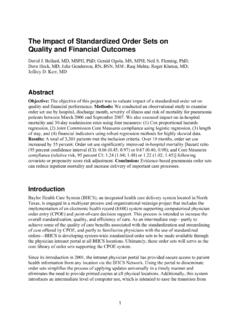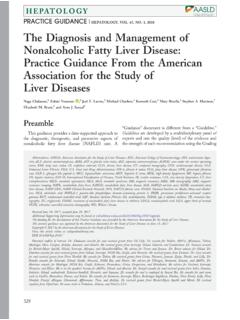Transcription of Improving Patient Flow and Reducing Emergency Department ...
1 Improving Patient Flowand Reducing EmergencyDepartment Crowding:A Guide for HospitalsImproving Patient Flow and Reducing Emergency Department Crowding:A Guide for HospitalsMegan McHugh, PhDKevin Van Dyke, MPPMark McClelland, MN, RNDina Moss, MPAO ctober 2011 AHRQ Publication No. 11(12)-0094 This document is in the public domain and may be used and reprinted without citation:McHugh, M., Van Dyke, K., McClelland M., Moss D. Improving Patient Flow and Reducing EmergencyDepartment Crowding: A Guide for Hospitals. (Prepared by the health Research & Educational Trust, anaffiliate of the American Hospital Association, under contract 290-200-600022, Task Order No. 6).AHRQ Publication No. 11(12)-0094. Rockville, MD: Agency for Healthcare Research and Quality; October 2011. The opinions presented in this report are those of the authors, who are responsible for its content, and donot necessarily reflect the position of the Department of health and Human Services or the Agencyfor Healthcare Research and : The authors would like to express their sincere gratitude to the Patient flowimprovement teams from the hospitals that participated in the Urgent Matters Learning Network(UMLN) I and II:iiGrady health SystemAtlanta, GABoston Medical CenterBoston, MA Henry Ford HospitalDetroit, MI Elmhurst Hospital CenterElmhurst, NY inova Fairfax HospitalFalls Church, VA BryanLGH Medical CenterLincoln, NE The Regional Medical Center at Memphis Memphis, TNSt.
2 Joseph's Hospital & Medical CenterPhoenix, AZ University Hospital San AntonioSan Antonio, TX University of California at San DiegoSan Diego, CA Thomas Jefferson University HospitalPhiladelphia, PA Hahnemann University HospitalPhiladelphia, PAStony Brook University Medical Center Stony Brook, NYGood Samaritan Hospital Medical Center Long Island, NYSt. Francis Hospital Indianapolis, IN Westmoreland Hospital Greensburg, PA The authors also thank the contributors who provided important feedback on this guide, includingrepresentatives from: Shore health system , Easton, MD; UMass Memorial Medical Center, Worcester,MA; and Baptist health Care, Pensacola, 1. The Need to Address Emergency Department Crowding ..5 Section 2. Forming a Patient Flow Team ..7 Section 3. Measuring Emergency Department 4. Identifying Strategies ..14 Section 5. Preparing to 6.
3 Facilitating Change and Anticipating 7. Sharing ..29 Appendix A. Guide to Online Resources Successfully Used by Hospitals to Improve Patient B. Implementation Plan Template ..32 Appendix C. Example Implementation Plan ..37 Appendix D. Additional Readings ..43iiiExecutive SummaryThe Need to Address Emergency Department CrowdingAlthough you, as a hospital or Department leader, are responsible for overseeing performance across anumber of dimensions, there are several reasons why addressing Emergency Department (ED) crowdingshould be at the forefront of your organization s improvement efforts:1. ED crowding compromises care ED crowding is Hospitals will soon report ED crowding measures to the Centers for Medicare & MedicaidServices (CMS).4. ED crowding compromises community ED crowding can be mitigated by Improving Patient flow throughout the purpose of this guide is to present step-by-step instructions for planning and implementing patientflow improvement strategies.
4 Forming a Patient Flow TeamThe importance of creating a Patient flow improvement team and giving careful thought to itscomposition cannot be underestimated. Numerous studies have shown the benefits of creating amultidisciplinary team to plan quality improvement interventions. We recommend that, at a minimum,your team include a team leader ( , day-to-day leader), senior hospital leader ( , chief qualityofficer), ED physicians and nurses, ED support staff ( , clerks, registrars), representatives frominpatient units, and a research/data analyst. It is important to include representatives from alldepartments that will be affected by your strategy, individuals who will serve as champions for yourstrategy, and those who may oppose your strategy so that their concerns may be ED PerformanceMeasurement is a fundamental tool to identify and eliminate variation in clinical processes.
5 Data alsocan be used to show that ED crowding is not just an ED problem, but one that requires hospital-widesolutions. Currently, hospitals are required to report several ED quality measures for example, the coremeasures and new measures are scheduled to start affecting hospital payment in 2013 and beyond( , median time from ED arrival to ED departure). We recommend all hospitals begin collecting dataon those measures now. Identifying StrategiesSelecting the right strategy is paramount for any successful intervention. Hospitals that devote sufficienttime up front to careful selection of a strategy often save time in the long run by avoiding having tomake major adjustments midstream. We recommend that your team take the following steps beforeselecting your improvement strategy: 11. Identify the most likely causes of the specific problems you Review available materials that describe what other hospitals have done to improve Patient Consider your to LaunchOnce the strategy is selected, we recommend that hospitals create a road map for the implementationprocess.
6 An implementation plan should be completed by the team and can help:1. Identify your goals and strategies. 2. Plan your Estimate the time and expenses associated with Identify performance completed, we recommend that you share your implementation plan with other hospital anddepartment leaders to ensure that they (1) are aware of the efforts underway and (2) understand thetimeline, budget, and resources that will be needed. Facilitating Change, Anticipating ChallengesFacilitating change often involves anticipating common challenges and taking steps to forestall them. We recommend several strategies for addressing those Approaches to Addressing Implementation Challenges 2 ChallengeRecommended ApproachRationaleCulture changeConstant reinforcement of the Signals to staff that the improvementstrategy by leadersstrategy will become standard procedureStaff resistanceStaff educationProvides staff with the capabilities and knowledge to carry out the strategyStaff resistancePost-implementation adjustments Signals responsiveness to staff concernsreflecting user recommendationsStaff resistance, culture Use of Lean quality improvementFosters a team environmentchange, and lack of methodsstaffing resourcesLack of staffing resources Robust data collectionProvides concrete evidence of need forStaff resistanceaction; demonstrates success to hospital leaders and frontline staff.
7 Is crucial in securing an executive championSharing Results Sharing results internally and externally is the key to sustainability and spread. Widely reporting theresults of multi-unit and Department initiatives helps create a culture of transparency and given the opportunity to compare their performance relative to other units will develop a healthycompetition to improve. We recommend the use of ED dashboards to provide a snapshot of key processvariables of particular interest to internal not all hospitals can participate in a formal collaborative, we recommend that all hospitals buildmomentum by sharing their results with external stakeholders through community partnerships, writtenpublications, and conference presentations. Some examples of potential outlets for sharing resultsinclude: community social service organizations that work with the hospital, other hospitals within asystem or in the hospital s metropolitan or State hospital association, local newspapers and blogs, tradepublications ( , Hospitals & health Networks, Modern Healthcare), peer-reviewed journals ( ,Joint Commission Journal on Quality and Patient Safety, Journal of Emergency Medicine, Journal ofEmergency Nursing), and professional societies ( , Society for Academic Emergency Medicine,American College of Emergency Physicians, and Emergency Nurses Association).
8 3 Section 1. The Need to AddressEmergency Department CrowdingMany Emergency departments (EDs) across the country are crowded. Nearly half of EDs report operatingat or above capacity, and 9 out of 10 hospitals report holding or boarding admitted patients in the EDwhile they await inpatient beds. Because of crowding, approximately 500,000 ambulances are divertedeach year away from the closest hospital. ED crowding has been the subject of countless news articles,lawsuits, and research studies. Although you, the hospital or ED leaders, are responsible for overseeing hospital performance across anumber of dimensions, there are several reasons why addressing ED crowding should be at the forefrontof your organizations improvement efforts. These include: 1. ED Crowding Compromises Care QualityEDs are high-risk, high-stress environments. When capacity is exceeded, there are heightenedopportunities for error.
9 The Institute of Medicine s (IOM s) six dimensions of quality (safety, effectiveness, Patient -centeredness, efficiency, timeliness, and equity) may all be compromised when patients experiencelong waits to see a physician, patients are boarded in the ED, or ambulances are diverted away from thehospital closest to the Patient . Over the past few years, several studies have presented clear evidence thatED crowding contributes to poor quality ED Crowding Is CostlyIn 2007, the most recent year for which data are available, million people representing 2 percent ofall ED visits left the ED before being seen, typically because of long wait walk-outsrepresent significant lost revenue for hospitals. The same is true of ambulance diversions. A 2006 study ata large academic medical center (AMC) found that each hour on diversion was associated with $1,086 inforegone hospital more recent study conducted at a different AMC showed that a 1-hourreduction in ED boarding time would result in over $9,000 of additional revenue by Reducing ambulancediversion and the number of patients who left without being crowded ED also limits the ability ofan institution to accept referrals and increases medicolegal risks.
10 3. Hospitals Will Soon Report ED Crowding Measures to CMSThe Centers for Medicare & Medicaid Services (CMS) announced the inclusion of five ED crowding-related measures under the Hospital Inpatient Quality Reporting Programainitiative: nPatient median time from ED arrival to ED departure for discharged patients (calendar year [CY] 2013).nDoor-to-diagnostic evaluation by a qualified medical professional (CY 2013).nPatient left before being seen (CY 2013).nMedian time from ED arrival to ED departure for admitted patients (FY 2014).nMedian time from admit decision time to time of departure for admitted patients (FY 2014).5aHospital Inpatient Quality Reporting Program. Overview available at will be required to report these measures to CMS in order to receive the full Medicare ,10 The measures were endorsed by the National Quality Forum in 2008,11and they are commonlyused by researchers to assess changes in ED crowding and Patient throughput.
